関連記事
関連キーワード
国際交流基金の関連事業
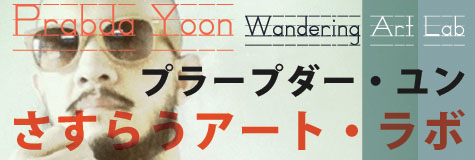
001 SANDWICH:教えることと学ぶことの間に存在する未完のスペース
プラープダー・ユン
小説家・アーティスト
アートは、教えられて習得できるものなのだろうか? 以前は違うと思っていた。でももしかしたら、私はこの疑問を狭い観点からとらえすぎていたかもしれない。もっといえば「アート」の意味を狭めすぎたかもしれない。アーティストとして成功し、リスペクトを受け、有名かつおもしろい存在に確実になれる方法を示すことを、アートの教育だとしたら、私の考えはそれほど的外れではなかったかもしれない。けれどアートは、職業上のツール以上の存在だし、そう理解するべきなのだ。一番重要で、本質的なレベルでは、アートは人生について考え、人生を受け入れる方法なのだ。
「人生」の意味はさておき、人生の生き方、とらえ方は無数にある。アーティスティックに世界を考えることもひとつのやり方で、クリエイティブな、また懐の広い教えを受ければ、より効果的な、よりやりがいのある方法で学ぶことができるのだと、今では思う。
私はアートスクールに通ったが、当時、自分がアート学生であるということに、ある意味、独特の憂鬱を感じていた。アート学生がみんな職業アーティストになるわけではないことも、職業アーティストになるアート学生が葛藤することも、誰もが知ってる。6年間アートを学んだけれど、どうやったらアートが自分の人生のなかに宿るのか、アートがどうやって自分をアーティスティックな展望に導いてくれるのかわからなかった。いわゆるアート・ワールドへのトンネルは救いようがないほど暗く見えた。でも確かなことが少なくともひとつあった。それはアートのない人生は考えられないということだ。その頃、アートの作り方だけじゃなくて、アートをスムーズに自分の人生に織り込む方法を教えてもらいたかったのにと感じていた。自分の進路はさておき、まったく「アート」と無関係かもしれない自分の人生に。
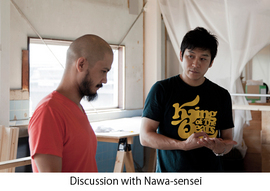 2004年の冬、名和晃平氏に初めて会ったのは、名和氏が京都造形芸術大学で教鞭を執る前だった。正直なところ、教育者としての彼は想像しにくかった。若くて、やる気満々で、明らかに日本の現代アートの世界を上り始めていた。少なくとも、キャリアの早い段階で教える仕事をするタイプの人間のプロフィールではなかった。だから何年か経って、名和氏が大阪に構えた最初のスタジオを訪れたとき、彼が30代前半ですでに野心あふれる若手アーティストたちの「名和先生」になっていたときには、当然驚いた。
2004年の冬、名和晃平氏に初めて会ったのは、名和氏が京都造形芸術大学で教鞭を執る前だった。正直なところ、教育者としての彼は想像しにくかった。若くて、やる気満々で、明らかに日本の現代アートの世界を上り始めていた。少なくとも、キャリアの早い段階で教える仕事をするタイプの人間のプロフィールではなかった。だから何年か経って、名和氏が大阪に構えた最初のスタジオを訪れたとき、彼が30代前半ですでに野心あふれる若手アーティストたちの「名和先生」になっていたときには、当然驚いた。
それからしばらく経って、名和氏は京都の南部の宇治川のそばに新しいスタジオに移動することを教えてくれた。彼は会話のなかで「SANDWICH」という言葉を何度も使ったけれど、なぜだかわからなかった。お腹が空いているのだろうか? 日本人にしかわからない冗談? 「SANDWICH」というのはもちろん今ではすっかり定着した名和氏のスタジオの名前で(おそらく人気ポップデュオゆずのミュージックビデオに登場する場所として一番知られていると思う)、地元のサンドイッチ工場を改造した2階建てのビルのことだ。建物内部は驚くほどまっさらの状態で、入っていくのもちょっと危険な状態だった初期の頃の「SANDWICH」を見た。名和氏によると、この建物は個人のスタジオとして機能するためでなく、「使いたい人なら誰でも」使えるクリエイティブなプラットフォームとして作られたものだということだった。
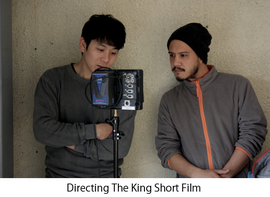 2009年に名和氏とコラボレーションした短編の映像作品を作るために、「SANDWICH」を再び訪れるまで、私は名和氏の意欲を斜めに見ていた。主演俳優(そして「SANDWICH」の技術の魔術師でもある)藤崎了一氏のニックネームにちなんで「ザ・キング」との題名をつけられたその作品は、全編、名和氏の学生やアシスタントで構成された小さなクルーの手で撮影された。この作品は、名和氏との初めてのアーティスティックなコラボレーションであり、まだ完成品にはほど遠いけれど、まったく違うアートのスキル、好み、気性の人々をとりまとめたという意味で「SANDWICH」は成功したと感じた。このユニークな、そして半永久的に建設中のスペースのおかげで、インスピレーショナルな雰囲気が生まれ、ほとんど暖房のきかない厳冬の真っ最中でも、クルーはやる気にあふれ、楽観的でい続けることができた。
2009年に名和氏とコラボレーションした短編の映像作品を作るために、「SANDWICH」を再び訪れるまで、私は名和氏の意欲を斜めに見ていた。主演俳優(そして「SANDWICH」の技術の魔術師でもある)藤崎了一氏のニックネームにちなんで「ザ・キング」との題名をつけられたその作品は、全編、名和氏の学生やアシスタントで構成された小さなクルーの手で撮影された。この作品は、名和氏との初めてのアーティスティックなコラボレーションであり、まだ完成品にはほど遠いけれど、まったく違うアートのスキル、好み、気性の人々をとりまとめたという意味で「SANDWICH」は成功したと感じた。このユニークな、そして半永久的に建設中のスペースのおかげで、インスピレーショナルな雰囲気が生まれ、ほとんど暖房のきかない厳冬の真っ最中でも、クルーはやる気にあふれ、楽観的でい続けることができた。
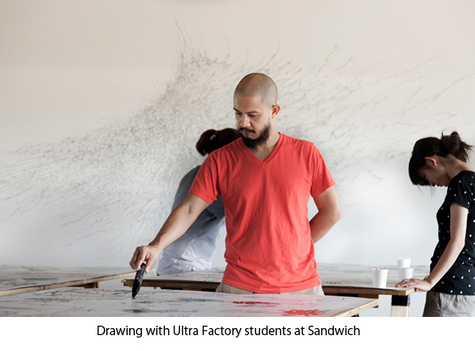
去年の8月、1ヶ月にわたり京都のレジデンス・プログラムに参加するまで、名和氏が教師として働く姿を見たことはなかった。名和先生は、私が「SANDWICH」に滞在した週に、「ウルトラ・ファクトリー」という名の特別講義で、ドローイングのワークショップを行うために学生を「SANDWICH」に連れてきた。ワークショップでは、年齢も、学力もばらばらの学生たちが、大判の紙をシェアし、作品が完成したと思うまで、共同でドローイングを行うことになっていた。私は日本語をカタコトしか知らないのに、名和先生の招待を受けて、ワークショップを監督することになった。最初は緊張したし、アガったが、学生たちの熱意、驚くほどの学習意欲のおかげで、最終的には英語で自分の考えを表現できるほどにリラックスできた。学生たちは、本気で私の言うことを理解したいと望んでいるようだった。
名和先生は、忍耐強く、型にはまらないタイプの教師だ。意見をシェアし、自分の感性をつかって指導する前に、学生たちには何度か自由に、そして自分の方法で探求させた。ドローイングを教えるのに、ドローイングの話をしない。そのかわり、耳をすませて聞こえる音を描くことを求めることもある。学生と一緒に作業して、行間の沈黙に自分が何を意図しているかを語らせる。
「SANDWICH」でのワークショップの最後に、学生たちから予期せぬ質問を受けた。「ドローイングが完成したと、どうやってわかるのでしょう?」
本当に優れた質問には答えはなく、この質問にも答えはなかった。でも役に立つ答えを待っている学生の集団に「わからない」とか、「知りようがない」と答えることは、無責任で残酷なことのように思えた。だから構図、テキスチャー、空っぽの空間、バランス、並列などについて、テクニカルな答えを提示しようとした。きっと何年も前に、自分が教師たちから得たのと同じ専門用語だったと思う。奇妙なことに、この気まずい、難しい瞬間が、アートを教えることの喜びを与えてくれた。ほぼ無理だと知っていても「ドローイングがどの時点でできあがるのか」を示す、実用的な方法を考えようとすることは、インスピレーションを与えてくれる、やりがいのある行為だった。
しかし、これがポイントだし、そうあるべきだ。あなたが私のように、たとえ「アート界」に生きていなかったとしても、アートのない人生が考えられないと感じるタイプの人間だとしたら。答えが半永久的に曖昧なものだと知りながら、終わりはいつなのか、自分に問い続けるドローイングのような存在として、人生をとらえることを学ぶべきなのだ。楽しいのは、その曖昧さに葛藤するところだ。アートを学ぶというのは、そういうことなのだ。
Photo by Sandwich Team
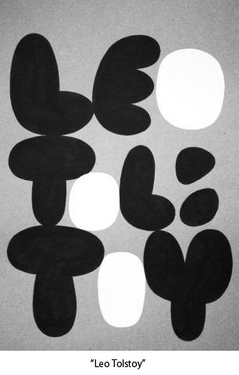
Sandwich: Unfinished Space Between Teaching and Learning, Part 1
Can art be taught? I used to believe not, but now I think I might have regarded the question from too narrow a perspective. Worse, I probably regarded the meaning of "art" too narrowly as well. If teaching art means to show someone a guaranteed way of becoming a successful, respected, famous, or even interesting, artist, then my initial hunch may have not missed the mark by much. But art is, or should be understood as, more than just occupational tool. At its most valuable, essential level, art is a way of looking at, indeed of embracing, life.
Regardless of what life is, we know that we can live or look at life with numerous attitudes. Living or looking at the world artistically is one attitude, and one which, I now think, can be learned and approached more effectively, rewardingly, through creative and generous teaching.
I went to art school, and I felt a peculiar melancholy in being an art student. Everyone knows that not all art students will become professional artists, and everyone knows that those who do will struggle. After 6 years of art education, I still didn't see how art would inhabit my life, how it would lead me to an "artistic" landscape. The tunnel to the so-called art world seemed too hopelessly dark. But I was sure of at least one thing: living without art was unthinkable. At that point I wished I had been shown not just how to make certain kinds of art but also the way to seamlessly weave art into my life, a life that might not, despite my choice of education, have anything to do with "Art" at all.
When I first met Nawa Kohei, in the winter of 2004, I think he had not yet started to teach at the Kyoto University of Art and Design (KUAD). Frankly, I couldn't really see him as a teacher. Young, determined, and clearly on the rise in Japan's Contemporary Art world, his profile just didn't fit someone who would take up a teaching job, at least not that early in his career. So I was surprised, naturally, when I visited him at his first studio in Osaka a few years later, to learn that he was now, only in his early thirties, Nawa-sensei to aspiring young artists.
Not long after that, Nawa told me he was moving to a new studio, a place by the Uji river in southern Kyoto. He kept mentioning the word "sandwich" in our conversation and I didn't understand why. Was he hungry? Was he making some kind of joke only the Japanese would get? Now well-established (perhaps most famously as the sole location in a music video for a song by the popular pop duo Yuzu), Sandwich is of course the name of Nawa's new studio, a two-story building converted from a local sandwich manufacturing factory. I saw Nawa's Sandwich almost from its beginning, when the interior was shockingly bare and a touch dangerous to walk in. Nawa informed me that this was not meant to function only as his personal studio; Sandwich would be a creative platform "for anyone who wishes to use it."
I was rather skeptical of his ambition until I returned to Sandwich in 2009, when Nawa and I collaborated on a short film. The film, entitled "The King" after the nickname of its actor (and Sandwich's technical wizard) Fujisaki Ryoichi, was shot entirely at Sandwich by a small crew, composed mostly of Nawa's students and assistants. It was our first artistic collaboration and the result is still far from finished, but I did feel that Sandwich itself was successful in bringing together individuals of different artistic skills, tastes, and temperaments. The unusual, indefinitely under construction space somehow helped to create an inspiring atmosphere, keeping the crew encouraged and optimistic, even during the midst of a brutal winter with little heating.
I never really saw Nawa in action as a teacher until this past August, during my one-month residency in Kyoto. Nawa-sensei brought his special class (called Ultra Factory) to Sandwich for a drawing workshop that lasted throughout the week of my visit. The students, a mixture in age and academic levels, were to share large sheets of paper and draw together until they felt the drawings were finished. Nawa-sensei invited me to join and to supervise the workshop, even though I knew only a few words of Japanese. I was nervous and self-conscious at first, but the enthusiasm of the students, their surprising eagerness to learn, helped me to relax, and I was eventually able to try to express my thoughts to them, in English. And I could tell they really wanted to understand me.
Nawa-sensei is a patient and unconventional teacher. He lets his students explore freely on their own several times before sharing his opinions and guiding them with his own sensibility. He doesn't teach drawing by talking about drawing. Instead, he will sometimes ask the students to listen and draw the sounds they hear. He draws with them and lets the silence in his lines tell them what he means.
At the end of the Sandwich workshop the students asked me something I hadn't anticipated: "How do we know when a drawing is finished?" Like all truly good questions, to this there is also no true answer. However, to say, "I don't know" or "there is no way to know" to a group of students genuinely waiting for a useful reply seemed irresponsible and cruel. So I tried to give a technical answer, something about composition, texture, empty space, balance, juxtaposition, etc. Probably the same sort of jargon I used to get from my teachers years ago. Strangely, this awkward and difficult moment made me feel the joy of teaching art. I found it inspiring, and highly challenging, to come up with a practical way to show "when a drawing is finished," knowing that it's perhaps an impossibility.
But that's the point, or should be, if you're, like me, the sort of person who feels that life without art is unthinkable, even if you don't live in the "art world." You have to learn to look at life as a drawing that constantly forces you to ask yourself when it's finished, knowing that the answer is infinitely ambiguous. The fun part is how you juggle that ambiguity. That's learning art.
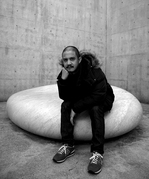 プラープダー・ユン
プラープダー・ユン
1973年生まれ、バンコクに拠点を置くタイの小説家・アーティスト。
多数の小説、短編小説やエッセイのコレクションを出版し、「ライ麦畑でつかまえて」「時計じかけのオレンジ」のような現代英語の古典文学もタイ語に翻訳。2002年に、彼の短編小説のコレクション「存在のあり得た可能性(英題:Probability)」で、タイで最も権威ある東南アジア文学賞を受賞。 他、プラープダーは定期的に日本で雑誌に執筆したり、アートのエキシビションを開催。また、映画「地球で最後のふたり」「インビジブル・ウェーブ」(主演:浅野忠信)の脚本や、現代アーティスト名和晃平の様々なアートプロジェクトにも協力。最新の小説は「パンダ」
Prabda Yoon
Born in 1973, a Thai writer and publisher based in Bangkok. He has published numerous novels, short story collections, and essay collections. In addition, he has also translated modern English-language classic literature such as The Catcher in the Rye and A Clockwork Orange into Thai. In 2002, his short story collection, Kwam Na Ja Pen (English: Probability), won the SEA Write Award.
Apart from working in Thailand, Prabda has regularly written for Japanese magazines and exhibited artworks in Japan. He has written 2 screenplays for films starring Tadanobu Asano and he is presently collaborating on various art projects with Japanese contemporary artist Kohei Nawa. His literary works have been translated into Japanese, of which the most recent is the novel Panda.

